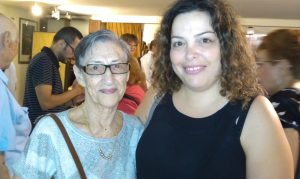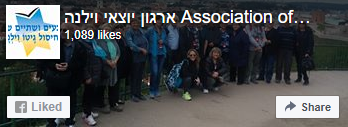Shoshana Shorenzon
 Back to the Pits of Death – the story of Shoshana Shorenzon
Back to the Pits of Death – the story of Shoshana Shorenzon
Seventy-one years after the massacre of the Jews of Vilna, 87-year old Shoshana Shorenzon returned to the place where her family and her husband's family were murdered in the Ponary forest on the outskirts of Vilna. Almost 80,000 were cruelly murdered after having undergone humiliation, torture and loss of humanity.
In July, 1941 the Germans occupied Vilna, the capital of Lithuania. They instigated pogroms against the Jews of the city that was considered the largest and most famous Jewish spiritual center; hence it was called "Jerusalem of Lithuania". With the enthusiastic cooperation of the Lithuanians, many Jews were humiliated, tortured and murdered in broad daylight in the alleys and main streets of the city and nobody said a word or did anything to stop it. The Jews were abandoned and, quite literally, left for dead.
In September, 1941 the Germans, with the help of their Lithuanian and Ukrainian helpers, began to assemble the Jewish males and take them to the Ponary forest near Vilna. In the forest, they were made to undress and were shot into massive pits that had been dug earlier by the Russians to store gas. The pits, which were from 14 to 30 meters wide and 8 meters deep, were filled with the bodies of those who had been exterminated; ever since then Ponary forest has been infamous and any mention of the place makes one shudder.
At the same time as the Jewish males were being exterminated, two ghettos were set up in Vilna and all the Jews were concentrated there under stifling conditions: 4 to 8 families in one small apartment. The conditions in the ghetto were appalling and the fight for survival was the order of the day. Because of the dire shortage of food, 14-year old Shoshana had to creep out of the ghetto and beg for food from gentiles she had known before the war. It was very risky but she had no alternative; her father and brother had already perished at the hands of the Germans and the Lithuanians and she had to support her grandparents and great-grandmother.
The situation worsened. Because of the stifling conditions the Germans took large groups of Jews on foot to Ponary Forest. Very few survivors returned from the inferno to report on the cruel things the Germans and their yes-men –the blood-thirsty Lithuanians and Ukrainians - had perpetrated. The Jews in the ghetto refused to believe that that was what had happened to the members of their families who had been taken from the ghetto. They all thought they had been taken to labor camps where the conditions were better. About 80,000 Jews from Vilna were exterminated at Ponary Forest and they remain buried in mass graves to this very day. That is where all Shoshana's family and that of her late husband Shalom Shorenzon, , are buried. Shalom was 16 years old when he stood at the edge of the pit with the other males of his family. They were all shot to death except Shalom, who was unharmed by the murderers' bullets. He pretended to be dead and at midnight, when it was quiet, he extricated himself from the pit and returned to the ghetto.
Shoshana decided to leave the ghetto and try her luck at a labor camp. After she had accumulated food and all sorts of valuables for her relatives she registered for work and was accepted. She was transferred to a camp where she paved roads and laid infrastructure for the railway. She had to unload train carriages that were full of gravel within a prescribed period of time. It was hard work but advantageous: there was enough to eat and she wasn't whipped. Every three weeks the workers were allowed to return to the ghetto to visit their relatives. On one of her visits, Shoshana could not find her grandparents. People told her that the grandparents had been taken. Where? Nobody knew. She was so grief-stricken that she did not return to the ghetto again.
A few months later, the forced labor workers were shunted into a goods train, like cattle, and taken to the Vaivara camp in Estonia, where they were housed in very cramped conditions. Food was scarce and illness and exhaustion took the lives of many Jews. Every day there was a selection parade: the weak and infirm were removed and never seen again.
At one of the parades one hundred young men and fifty young women, including Shoshana were taken to the Kivili camp where they built a hospital for the German wounded soldiers. They then labored on the farms in the local village. Despite the intense cold, this work was a savior from the terrifying parades; the prisoners were also able to eat fresh fruit and vegetables secretly and drink milk from the cows that grazed in the fields. There was very harsh discipline: the slightest infringement was punished with whippings, torture and heavy punishments.
Not far from the Kivili camp there was a camp of Russian prisoners who were employed doing forced labor such as building roads and digging trenches. Shoshana and her friends were also ordered to do this work. Shoshana and her friend Sima met up with a Russian prisoner and they planned to escape; they managed to do so and wandered around for six days before they were caught. Sima and the Russian prisoner were murdered immediately and her captors planned to take Shoshana back to the camp to hang her publicly to deter other prisoners from trying to escape. Fortunately for her, her punishment was commuted to whippings thanks to the intervention of a Jewish Kapo who lobbied for her. She was also given another punishment: to carry water containers to the kitchen from afar.
Meanwhile the Russian front came nearer. The Germans hastened to empty the camp where there were twenty thousand prisoners. The prisoners started walking towards the port of Ribalta on the Baltic coast. They were unable to feed all the prisoners so they crammed them onto boats, let them sail to the open sea, threw the prisoners into the cold water and left them there to drown. Since the Russian front was coming closer, they decided to transfer the remaining prisoners to the Stutthof camp which was Hell on earth. There were Jews from all over Europe at this camp. They were crammed into housing blocks. Many people died during the extremely cold winter of 1944-1945, exacerbated by hunger, illness and exhaustion. Every day there was a selection. The infirm and the weak were sent to the crematorium. Hundreds died or were put to death daily. The healthy ones were forced to dig up potatoes from the frozen ground or to dig trenches for the soldiers. The Lithuanian, Ukrainian and German soldiers whipped them mercilessly and shot anyone who tried to take a short break.
The Russian front came even closer and the prisoners were forced to start marching again on a death march in the freezing cold, without food, warm clothes and proper shoes. Many fell along the wayside and died; others were shot because they lagged behind. The trials and tribulations of the marchers are indescribable. They marched for six weeks until they reached a small German village.
Only four thousand of the twenty thousand prisoners remained. They were crammed in and around an enormous barn. They died like flies. The exhaustion, hunger and feeling of devastation made them apathetic towards death. People died every day from the cold, typhoid and hunger. Shoshana also fell ill and lay, unable to move.
And then… on the 11th March, 1945 the soldiers of the Red Army arrived and liberated the remnant of European Jewry. At first, they thought that Shoshana was dead but her friend noticed that she was still breathing; she was so thin that she only weighted 35 kilograms. She was hospitalized, treated and survived; she returned to Vilna, but there was nobody there. Her whole family had perished and she was alone in the world. The Joint Distribution Committee (JDC) assembled all the survivors at the school and there she met Shalom Shorenzon, who was also the sole survivor of his whole family. They were married in a sad ceremony and had a son and a daughter. Six years later they managed to flee from Lithuania, made aliyah and settled in Ashdod. Shalom passed away about seven years ago and their daughter died of cancer about a year ago
Seventy-one years after the massacre at the pits of Ponary Forest, Shoshana decided to take her son and seven grandchildren on a journey to her birthplace and to the Valley of Death in the Ponary Forest. Over the past few years she has saved every cent so that she could buy them all tickets and cover the expenses of the trip. Hence, on Holocaust Memorial Day Shoshana will stand, proud, still pining, in front of the monument memorializing those who perished at the Ponary Forest to light the memorial candle in memory of her beloved ones. Hopefully, she will be strong enough to do so.
Written by Shim'on Ya'akovi

